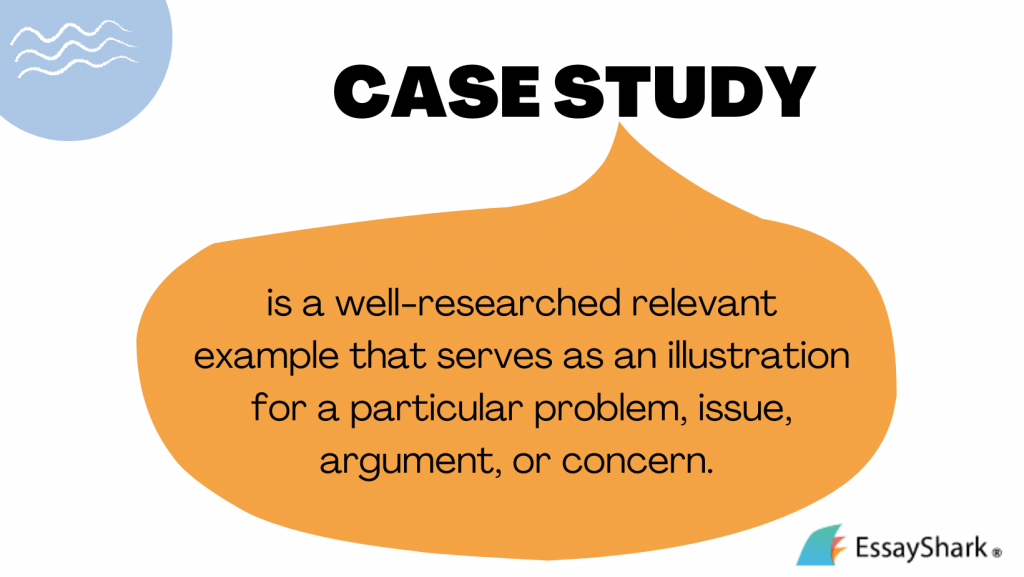If you study in college, it’s unlikely that you’ve never heard about a case study. Researchers widely use case study format for their research no matter what their field of study is: marketing, medicine, business, media, law, communications, economy, or sociology. Sooner or later, every student must face the problem of providing a case study. We are eager to help our hard-working and inquisitive readers to learn more on how to write a case study.
Although the written part of such an assignment is called a case study report, students generally use the term “case study,” implying the report. In our article, we’ll talk mostly about the case study itself. However, we’ll also provide you with information on how to write a case study report in a separate section.
Table of Contents
First of all, let’s define a case study in order to avoid any confusion in the future.
What is a case study?

A case study is a well-researched relevant example that serves as an illustration for a particular problem, issue, argument, or concern. It can also be defined as a method for a deeper understanding of a problem, organization, activity, or event. You shouldn’t mistake it for the case method that is used as a teaching strategy.
In a case study, the case serves as the topic of your research. As a rule, you research a particular phenomenon: a person, group of people, organization, activity, process, or problem. It can be some relevant present-day query like topics on sex education or the issue of post-truth politics. Depending on the chosen case, your study will be one of the following:
- A single instrumental case study: firstly, you choose a certain problem/concern, and then you focus on one case that illustrates this issue.
- A multiple case study: you also choose a certain issue, but focus on more than one bounded case.
- An intrinsic case study: you don’t concentrate on any problem, as you choose one unique case and analyze it without connecting to a particular concern.
Although case study format may vary, all works of this type have a range of common peculiarities. So, what are the main characteristics of the great case study sample?
What makes a great case study?
1. Full picture
Every case study should be based on multiple sources of data in order to provide an exhaustive presentation of the subject.
2. Systematic investigation
All data on the subject should be well-structured in order to create reliable materials for further studies.
3. Natural setting
Case studies are NOT EXPERIMENTS! You don’t examine a phenomenon under laboratory conditions. The contextual aspect allows the studying of events and processes in real circumstances, taking into account a range of various external factors.
4. Narrow research question
When writing a case study, focus on specific data or solutions. You shouldn’t produce new theories or answer general questions on the topic. Think of it as arguments for euthanasia essay: You need in-depth insight into the phenomenon that’s tightly connected with your research questions.
5. Qualitative and quantitative approaches
Case studies use both quantitative and qualitative approaches, though they are mostly focused on the latter. Consequently, the most frequently used methods of data collection are: research interviews, surveys and questionnaires, document analysis, historical research, etc.
6. Bounded system
A phenomenon should be bounded to be a case. Before beginning your study, you should firstly define the case boundaries – place or time period.

Common types of case studies due to aim
All case studies have common characteristics like continuity, a deep and thorough analysis, qualitative and quantitative research methods, etc. At the same time, every case study has different goals, and that defines its types.
Usually, a case study can:
- define the questions for a further study;
- provide a contextual description of the event, person, company, etc.;
- analyze a cause-and-effect relationship.
The main goal determines the character of your case study. All case studies can be typified as:
- Exploratory – defines the questions for a further study/for future research.
This type is the most common, as the frequent goal of a case study is to explore a new area or phenomenon and collect data for further studies. The exploratory approach is an open technique that is focused on observation and collecting various information. This technique is often appropriate for a case study, as it allows students to learn more about absolutely unknown subjects without any preparations or background information.
- Descriptive – provides a contextual description of the event, person, company, etc.
The second way to provide a case study is to compose an in-depth, detailed, and nuanced description of the situation. If, say, you write a Doll’s House essay, you should focus on one particular theme and specify its contextual details instead of explaining the whole range of problems covered by the author. Do your best to define the case study’s boundaries clearly.
- Explanatory – analyzes a cause-and-effect relationship (outcomes generated from certain circumstances).
The last type may seem difficult as it requires deep analysis, objective evaluation, discovering connections, and, sometimes, making a forecast. You have to find out what causes entail which consequences.
6 important steps in writing a case study
Case study writing can be a challenge for students. However, everything becomes easier when you have a good step-by-step plan. Below, you’ll find a detailed instruction that will help you to fight a case study problem. Follow our lead and produce an excellent case study sample!

1. Choose a case or an issue.
Depending on your type of case study (single instrumental, multiple, or intrinsic), you should pick a case, a few cases, or a problem that you’ll research. As a rule, your instructor will assign a specific research question or share particular requirements for you to follow in your case study. Otherwise, you’re free to choose an issue on your own; when you get stuck, an essay title generator might inspire you and help you find keywords for your potential topic.
Example of a case for a single instrumental case study:
Netflix in India: Governmental Policy and Its Implications for Multinational Corporations.
Example of cases for a multiple case study:
Netflix in India and Google in China: Governmental Policy and Its Implications for Multinational Corporations.
Example of an issue for an intrinsic case study:
The Development Issues of Multinational Corporations on Foreign Markets.
2. Determine the type of the case study.
Exploratory, descriptive, and explanatory case studies require different strategies and methods. Before beginning your work, determine what type of case study you want to produce.
3. Design a study.
Develop a framework or a case study template to make sure that your work is well-considered. Take your time to think over all details to avoid confusions in the future.
4. Collect and analyze data.
The process of gathering data is the same for any type of case study. You observe, ask questions, interview employees and specialist, read numerous documents, etc. On the other hand, a data analysis can be provided in different ways.
For a single instrumental case study, you categorize data into particular themes; this method is called “analysis of themes.”
For a multiple case study, data analysis includes two steps: firstly, you look for common themes in each case and examine them separately (within-case analysis), and then you look for connections between common themes in different cases (cross-case analysis).
5. Conclude your work.
Think about lessons you’ve learned, the meaning of the data you’ve gathered and analyzed, and the possibility of further studies. Remember that your case study can become a basis for someone else’s work, so be responsible and accurate!
6. Provide a case study report.
The written part of your case study is utterly important, as it represents the results of your work and can be shared with other researchers. Your case study report should be written in concise academic language according to the formatting style specified by your instructor. Below, you’ll find a more detailed plan on how to write a case study report.
We hope that you’ll quickly and easily make all these steps to write a case study, and get an impressive result. Now, let’s take a closer look at a case study report.
How to write a case study report
When you’ve collected and classified all necessary data on your subject, it’s the right time to start writing your case study report. This is the final stage of your case study, and demonstrates the results of your work. You should be very accurate while composing your report because it may serve as a basis for further studies of other researches.

Every report consists of seven major elements:
1. Cover page
A cover page or title page includes general information on the author and work: student’s name, case study title, and date of submission.
2. Summary
A summary is a brief review of your case study where you mention the subject, methods, and important findings. As a rule, the summary is written last.
3. Introduction
The introduction of the case study provides readers with background information on your case and describes the current situation.
4. Main body
The main body is the heart of your case study. Issues, goals, problems, findings, data analysis, recommendations, and predictions – you include all these parts in the main body.
5. Conclusion
A concise conclusion should emphasize the meaning of your findings and restate the key points of your case study. At the same time, it should not be simply a summary of your main body.
6. Works cited page
Every research should be based on reliable sources, and every source should be properly cited. While working on your case study, don’t forget to record all of your sources. Otherwise, you can be accused of plagiarism.
7. Appendices
This part includes all additional materials that are connected with your case study sample: charts, images, tables, statistics, etc. You should refer to them in the text of your writing.
Remember that your case study report is the only material representation of your work! Stick to the required formatting style, follow instructions, and proofread your writing properly! You need to follow a prescribed essay writing format for students when structuring your case study: Ensure that you’ve understood the prompt and learned the formatting guidelines of your assigned citation style (APA, MLA, etc.).
Case study examples at EssayShark.com
The quickest way to process new information is to find a proper example. The same applies to case study writing. This type of assignment can be rather challenging especially for freshmen, so don’t neglect the opportunity to read some examples before writing your own.
We don’t guarantee that it will be easy to find the best case study templates on the internet. Anyway, we offer you to check out some of our samples placed on the blog. At the first place, let’s take a closer look at three case study templates that can be categorized by their aim:
- The exploratory case study sample observes employee motivation and retention strategies at Microsoft.
- The descriptive case study sample provides a detailed and nuanced report on Zara’s current market situation.
- The explanatory case study sample analyzes whether Intel should penetrate the smart phone market and tablet market or not.
- Students who are looking for a short business case study report should check out our case study sample about Barilla S.p.A., which is one of the largest manufacturers of Italian spaghetti in the world.
- An advertising case study sample will be a great example of the single-instrumental case study.
Case study research is an academic assignment of the high difficulty. We are sure that our guide on how to write a case study has helped you to figure out all significant details about this research method. Don’t forget to check out our well-written case study samples placed on the blog!
As you can see, a case study is no joke. This work requires profound research, deep analysis, and proficient writing skills! Luckily to you, our writers at EssayShark.com are experienced enough to deal with any kind of academic assignment.
You can write a case study from scratch and spend a few sleepless nights to do your homework. Still, there is no guarantee that your instructor will appreciate your efforts.
We offer you a simple solution: get a case study in a few steps at our writing service! You don’t have to solve your academic problems alone: EssayShark.com is available 24/7! Our service is a perfect place to enlist the support of well-educated writers at an affordable price. Place your order, and we’ll start working in the blink of an eye!








